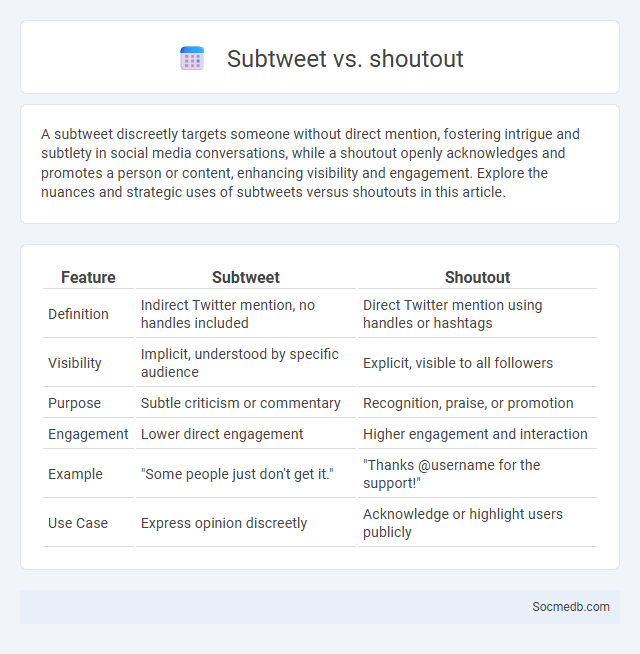
Photo illustration: Subtweet vs Shoutout
A subtweet discreetly targets someone without direct mention, fostering intrigue and subtlety in social media conversations, while a shoutout openly acknowledges and promotes a person or content, enhancing visibility and engagement. Explore the nuances and strategic uses of subtweets versus shoutouts in this article.
Table of Comparison
| Feature | Subtweet | Shoutout |
|---|---|---|
| Definition | Indirect Twitter mention, no handles included | Direct Twitter mention using handles or hashtags |
| Visibility | Implicit, understood by specific audience | Explicit, visible to all followers |
| Purpose | Subtle criticism or commentary | Recognition, praise, or promotion |
| Engagement | Lower direct engagement | Higher engagement and interaction |
| Example | "Some people just don't get it." | "Thanks @username for the support!" |
| Use Case | Express opinion discreetly | Acknowledge or highlight users publicly |
Understanding Subtweet: Definition and Origin
A subtweet is a social media post that indirectly references or criticizes someone without naming them, often used to express feelings or opinions without direct confrontation. Originating from Twitter's unique character limit and culture, subtweets have become a common tool for users to share coded messages, vent frustration, or spark curiosity among followers. Understanding subtweets helps you decode hidden meanings and navigate online interactions more effectively.
What Is a Shoutout? Key Differences
A shoutout on social media is a public endorsement where a user mentions or tags another account to share their content or promote them to their followers. The key differences between shoutouts and regular posts lie in the purpose and interactivity; shoutouts are specifically used to increase visibility and build networks, often involving direct calls to action or collaborative partnerships. Your brand can leverage shoutouts to boost reach quickly, tapping into audience trust through genuine recommendations.
Semantic Differences: Subtweet vs Shoutout
A subtweet subtly references someone on social media without direct tagging, often conveying criticism or sarcasm, while a shoutout openly acknowledges or praises a person, brand, or content by tagging them. Understanding these semantic differences is crucial for interpreting tone and intent in your digital interactions. Using the right approach can enhance your social media strategy and communication effectiveness.
Intentions Behind Subtweeting
Subtweeting often stems from intentions to express feelings indirectly, avoid confrontation, or signal information to specific audiences without explicit mention. Your motivations might include seeking validation, venting frustrations, or influencing social circles subtly. Understanding these underlying drivers can help decode the nuanced communication patterns within social media interactions.
The Social Impact of Shoutouts
Shoutouts on social media amplify visibility for individuals and brands, driving engagement and fostering community growth by leveraging collective networks. They serve as powerful tools for social validation, boosting credibility and trust among followers through peer endorsements. The ripple effect of shoutouts can accelerate influence and support social causes by mobilizing diverse audiences quickly and effectively.
Subtweet vs Shoutout: Usage Patterns
Subtweets often serve as indirect commentary or criticism of someone without mentioning them explicitly, creating a subtle or passive-aggressive communication style. Shoutouts, conversely, function as explicit acknowledgments or endorsements that actively promote or thank an individual or brand within social media platforms. Understanding these usage patterns helps optimize your online interactions by choosing between subtlety in subtweets or direct engagement via shoutouts.
Psychological Effects on Audiences
Exposure to social media can significantly impact Your mental health by influencing self-esteem, anxiety levels, and mood regulation. Platforms often create environments that encourage social comparison, leading to feelings of inadequacy or social isolation. Persistent engagement may also alter attention spans and increase susceptibility to stress and depression.
Brand Strategy: When to Use Each
Your brand strategy should align with the unique strengths of each social media platform to maximize engagement and reach. Use Instagram for visual storytelling and brand aesthetics, LinkedIn to establish thought leadership and B2B connections, and Twitter for real-time updates and customer interaction. Selecting the right platform based on your brand goals ensures effective communication and drives measurable results.
Examples of Subtweets and Shoutouts
Subtweets often appear as indirect, critical messages on platforms like Twitter, where users refer to someone without tagging them explicitly, such as "Some people just can't take responsibility for their actions." Shoutouts serve as positive mentions to boost visibility, as seen when influencers tag collaborators: "Huge shoutout to @EcoBrand for their sustainable products!" Both subtweets and shoutouts leverage language to influence social dynamics and engagement within social media communities.
Navigating Online Etiquette and Boundaries
Navigating online etiquette and boundaries on social media involves understanding platform-specific norms and respecting personal privacy settings. Clear communication and mindful interactions help prevent misunderstandings and promote positive digital relationships. Recognizing the impact of tone, timing, and content sharing is essential to maintaining professionalism and empathy across social networks.
 socmedb.com
socmedb.com